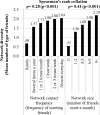Is Social Network Diversity Associated with Tooth Loss among Older Japanese Adults?
- PMID: 27459102
- PMCID: PMC4961379
- DOI: 10.1371/journal.pone.0159970
Is Social Network Diversity Associated with Tooth Loss among Older Japanese Adults?
Abstract
Background: We sought to examine social network diversity as a potential determinant of oral health, considering size and contact frequency of the social network and oral health behaviors.
Methods: Our cross-sectional study was based on data from the 2010 Japan Gerontological Evaluation Study. Data from 19,756 community-dwelling individuals aged 65 years or older were analyzed. We inquired about diversity of friendships based on seven types of friends. Ordered logistic regression models were developed to determine the association between the diversity of social networks and number of teeth (categorized as ≥20, 10-19, 1-9, and 0).
Results: Of the participants, 54.1% were women (mean age, 73.9 years; standard deviation, 6.2). The proportion of respondents with ≥20 teeth was 34.1%. After adjusting for age, sex, socioeconomic status (income, education, and occupation), marital status, health status (diabetes and mental health), and size and contact frequency of the social network, an increase in the diversity of social networks was significantly associated with having more teeth (odds ratio = 1.08; 95% confidence interval, 1.04-1.11). Even adjusted for oral health behaviors (smoking, curative/preventive dental care access, use of dental floss/fluoride toothpaste), significant association was still observed (odds ratio = 1.05 (95% confidence interval, 1.02-1.08)).
Conclusion: Social connectedness among people from diverse backgrounds may increase information channels and promote the diffusion of oral health behaviors and prevent tooth loss.
Conflict of interest statement
Figures
Similar articles
-
Is the Association between Green Tea Consumption and the Number of Remaining Teeth Affected by Social Networks?: A Cross-Sectional Study from the Japan Gerontological Evaluation Study Project.Int J Environ Res Public Health. 2020 Mar 20;17(6):2052. doi: 10.3390/ijerph17062052. Int J Environ Res Public Health. 2020. PMID: 32244856 Free PMC article.
-
Socioeconomic status and remaining teeth in Japan: results from the Toyama dementia survey.BMC Public Health. 2019 Jun 4;19(1):691. doi: 10.1186/s12889-019-7068-7. BMC Public Health. 2019. PMID: 31164111 Free PMC article.
-
The different effects of vertical social capital and horizontal social capital on dental status: a multilevel analysis.Soc Sci Med. 2009 Aug;69(4):512-8. doi: 10.1016/j.socscimed.2009.06.003. Epub 2009 Jul 1. Soc Sci Med. 2009. PMID: 19573968
-
Experience of childhood abuse and later number of remaining teeth in older Japanese: a life-course study from Japan Gerontological Evaluation Study project.Community Dent Oral Epidemiol. 2016 Dec;44(6):531-539. doi: 10.1111/cdoe.12246. Epub 2016 Jul 15. Community Dent Oral Epidemiol. 2016. PMID: 27417875
-
Inequalities of dental prosthesis use under universal healthcare insurance.Community Dent Oral Epidemiol. 2014 Apr;42(2):122-8. doi: 10.1111/cdoe.12074. Epub 2013 Sep 18. Community Dent Oral Epidemiol. 2014. PMID: 24102497
Cited by
-
Does social support predict increased use of dental services in older men?Aust Dent J. 2022 Sep;67(3):262-270. doi: 10.1111/adj.12911. Epub 2022 Apr 21. Aust Dent J. 2022. PMID: 35373341 Free PMC article.
-
Do changes in income and social networks influence self-rated oral health trajectories among civil servants in Brazil? Evidence from the longitudinal Pró-Saúde study.BMC Oral Health. 2022 Apr 29;22(1):153. doi: 10.1186/s12903-022-02191-5. BMC Oral Health. 2022. PMID: 35488334 Free PMC article.
-
Frequency of Going Outdoors and Risk of Poor Oral Health Among Older Japanese Adults: A Longitudinal Cohort From the Japan Gerontological Evaluation Study.J Epidemiol. 2024 Feb 5;34(2):63-69. doi: 10.2188/jea.JE20220221. Epub 2023 Aug 31. J Epidemiol. 2024. PMID: 36967120 Free PMC article.
-
Factors associated with subjective oral health among older adults aged 65 and over living alone: the role of social capital.BMC Public Health. 2025 Apr 15;25(1):1401. doi: 10.1186/s12889-025-22649-9. BMC Public Health. 2025. PMID: 40234800 Free PMC article.
-
Is the Association between Green Tea Consumption and the Number of Remaining Teeth Affected by Social Networks?: A Cross-Sectional Study from the Japan Gerontological Evaluation Study Project.Int J Environ Res Public Health. 2020 Mar 20;17(6):2052. doi: 10.3390/ijerph17062052. Int J Environ Res Public Health. 2020. PMID: 32244856 Free PMC article.
References
-
- Sheiham A, Steele JG, Marcenes W, Lowe C, Finch S, Bates CJ, et al. (2001) The relationship among dental status, nutrient intake, and nutritional status in older people. J Dent Res 80: 408–413. - PubMed
-
- Cabinet Office, Government Of Japan (2013) Annual Report on the Aging Society: 2014. Tokyo: Cabinet Office, Government Of Japan,.
MeSH terms
LinkOut - more resources
Full Text Sources
Other Literature Sources


